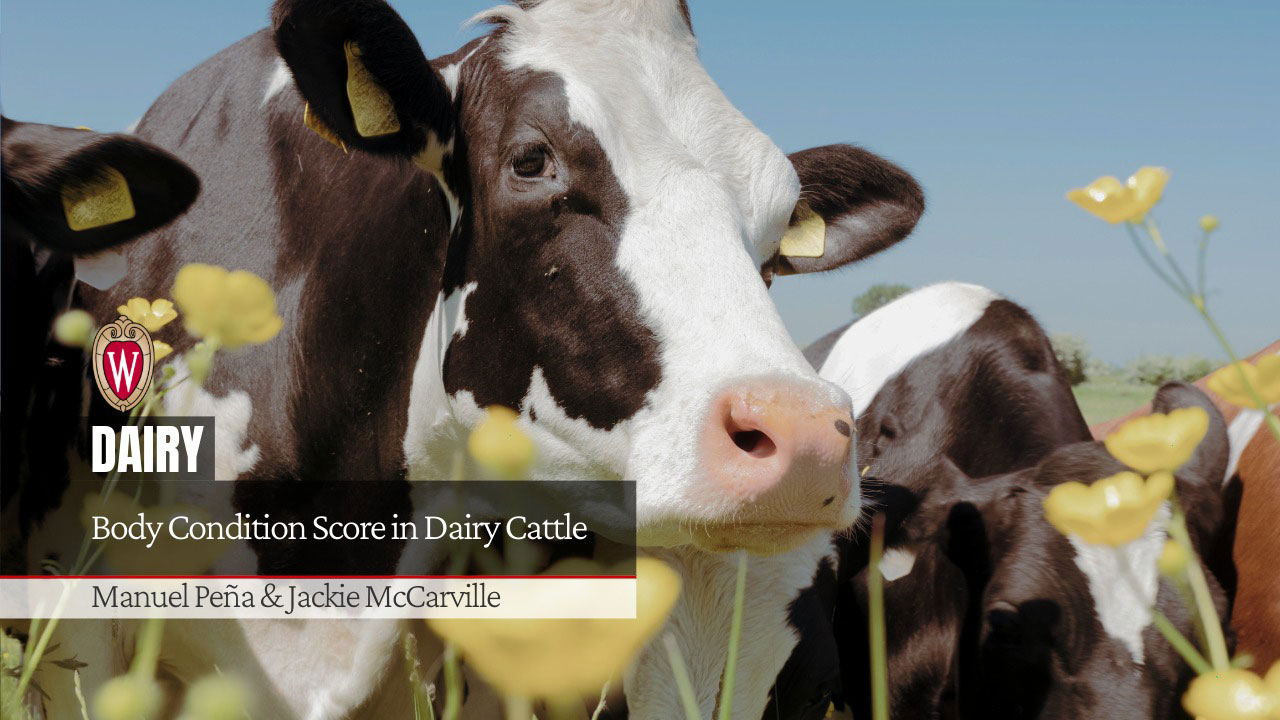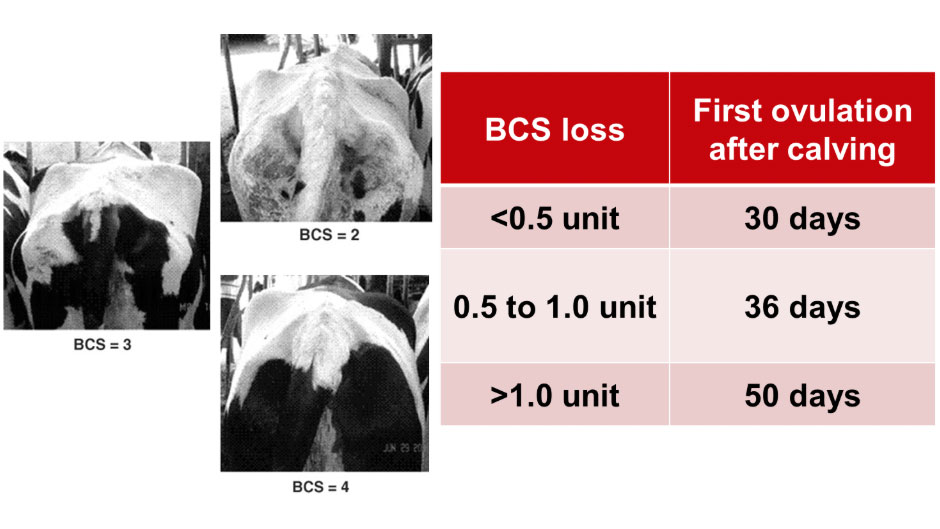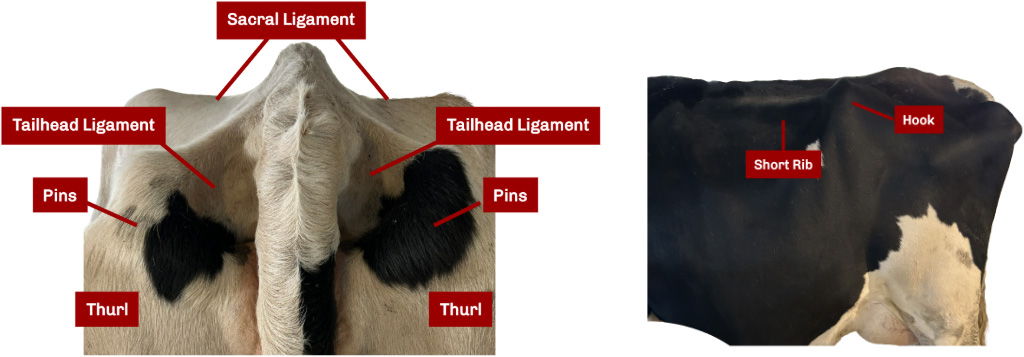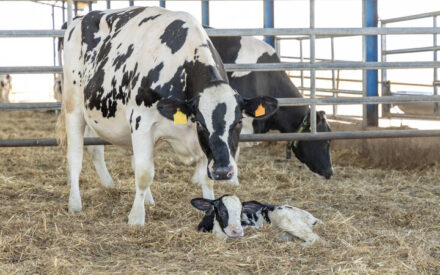
Introduction
Body Condition Score (BCS) is widely accepted as a practical method for assessing fat reserves in dairy cattle. Fat stores serve as an important energy source during lactation, allowing mothers to produce milk even during periods of feed restriction or high energy demand. In production systems, BCS remains a topic of interest due to its impact on reproduction, longevity, productivity, and overall health. Monitoring BCS throughout the lactation and transition phases is especially key to ensure the health of dairy cattle. The scoring system ranges from 1 to 5, based on how thin or fat the animal is.
Why Body Condition Score is important
Cows that lose body condition rapidly after calving are at higher risk for metabolic disorders, reduced fertility, and other health issues if their energy needs are not met. In early lactation, cows typically produce more milk than can be supported by dry matter intake alone, called negative energy balance, requiring them to draw on stored body energy. Conversely, over-conditioned cows at calving are more likely to experience calving difficulty, along with digestive, reproductive, and other problems that may persist in lactation. Additionally, when a cow has a high BCS during the transition period, she has an increased risk of lower dry matter intake around calving. This can prolong the negative energy balance at the start of lactation and limit milk production. Condition gain typically occurs in late lactation, when milk production declines, but cows continue to consume a high-energy diet. The following graph illustrates this period of negative energy balance at the beginning of lactation that can cause BCS loss as well as how dry matter intake surpasses milk production later in lactation leading to BCS gain.

Graph from Penn State Extension website ↗️
Losing some condition, about 0.5 to 1.0 points of BCS, during the first 60 days of lactation is considered normal. A BCS at 3.0 at calving is ideal and results in more milk production compared to cows with higher or lower body condition scores. These cows can efficiently use stored body fat for energy without experiencing the negative effects associated with over-conditioning. Scores higher than 3.5 at calving are not recommended. Cows that lose more body weight will take longer to ovulate. If BCS loss is less than 0.5 points, ovulation typically occurs in 30 days postpartum. If more than 1.0 points are lost, ovulation may be delayed beyond 50 days or may not occur at all. Similarly, the conception rates are affected by BCS. It has been reported that cows with a lower BCS or the ones who lost more than 1.0 units of BCS after calving have lower conception rates.

How to Body Condition Score (BCS)
Body Condition Scoring can be subjective and a cow’s score can vary from person to person. Due to this, it is recommended that the same person or group of people evaluate body condition each time. BCS should be evaluated at dry off, 3-4 weeks before calving, at calving, and 60 days post calving. As mentioned above, BCS is ranked on a scale of 1 to 5 with .25 increments. A score of 1 is a severely skinny animal and 5 is obese. Scoring is done by looking at hooks, pins, thurl, short ribs, tailhead ligament, and sacral ligament on each animal. The target BCS is between 2.5-3.0 during lactation. A general rule of thumb is to have greater than 85% of your herd within the targeted BCS range.

(Photo: Jackie McCarville).
| BCS | Characteristics |
|---|---|
| 1 |
|
| 2 |
|
| 3 |
|
| 4 |
|
| 5 |
|
Research shows that maintaining target BCS levels at specific stages of lactation supports optimal energy balance, which improves milk yield, reproductive performance, and disease resistance.
Author

Manuel Peña
Regional Dairy Educator

Jackie McCarville
Regional Dairy Educator – Jackie’s primary focus is dairy operations. She has experience in the private sector in animal nutrition and on dairy farms.
Reviewers
Paul Fricke
Dairy Cattle Reproduction Extension Specialist, Professor
University of Wisconsin-Madison, Division of Extension
Katelyn Goldsmith
Dairy Outreach Specialist
University of Wisconsin-Madison, Division of Extension
Matt Lippert
Dairy Educator
University of Wisconsin-Madison, Division of Extension
References
- Bewley, J.M. and Schultz, M.M. (2008). Review: An interdisciplinary review of body condition scoring for dairy cattle. The Professional Animal Scientist, 24(6), 507-529. https://doi.org/10.15232/S1080-7446(15)30901-3
- Gearhart, M.A., Curtis, C.R., Erb, H.N., Smith, R.D., Sniffen, C.J., Chase, L.E., & Cooper, M.D. (1990). Relationship of changes in condition score to cow health in Holsteins. Journal of Dairy Science, 73(11), 3132-3140. https://doi.org/10.3168/jds.S0022-0302(90)79002-9
- Heinrichs, J., Ishler, V., & Jones, C. (2023). Body condition scoring as a tool for dairy herd management. PennState Extension. https://extension.psu.edu/body-condition-scoring-as-a-tool-for-dairy-herd-management
- National Dairy FARM Program. (2022). FARM Animal Care, Reference Manual Version 4. FARM_Animal-Care-4-Manual_Layout_FINAL_112921.pdf
- Fricke, P. M., Wiltbank, M. C., & Pursley, J. R. (2023). The high fertility cycle. JDS Communications, 4(2), 127–131. https://doi.org/10.3168/jdsc.2022-0280
- Roche, J.R., Friggens, N.C., Kay, J.K., Fisher, M.W., Stafford, K.J., & Berry, D.P. (2009). Invited review: Body condition score and its association with dairy cow productivity, health, and welfare. Journal of Dairy Science, 92(12), 5769-5801. https://doi.org/10.3168/jds.2009-2431
- Butler, W.R. and Smith, R.D. (1989). Interrelationships between energy balance and postpartum reproductive function in dairy cattle. Journal of Dairy Science, 72(3), 767-783. https://doi.org/10.3168/jds.S0022-0302(89)79169-4


 ▶️ Watch: Nutritional Strategies to Reduce Methane Emissions in Lactating Cows
▶️ Watch: Nutritional Strategies to Reduce Methane Emissions in Lactating Cows ▶️ Watch: How Can Nutrition Help Us in Taming Inflammation and Improving Cow Health
▶️ Watch: How Can Nutrition Help Us in Taming Inflammation and Improving Cow Health Activity Monitoring Technology for Reproductive Management of Dairy Cows
Activity Monitoring Technology for Reproductive Management of Dairy Cows ▶️ Watch: Preparing Calves for the Road Ahead
▶️ Watch: Preparing Calves for the Road Ahead


